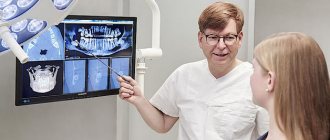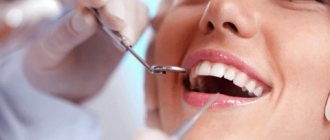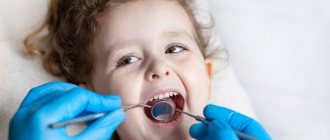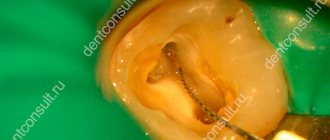An x-ray is the dentist’s main tool in making the correct diagnosis. However, a conventional orthopantomogram or targeted photograph has limited diagnostic potential and does not provide complete data on the condition of the teeth and maxillofacial area. But technologies are constantly being modernized and today, more informative technology has come to the aid of conventional radiography - dental computed tomography (CT).
What does a 3D dental x-ray show?
3D dental tomography is a highly accurate diagnostic method that makes it possible to obtain a three-dimensional image of the dental system in different projections. Volumetric images obtained with CT allow the specialist to enlarge, rotate and examine the area of interest from all sides and at different depths:
- The entire maxillofacial apparatus.
- A dentition or an individual tooth.
- Paranasal sinuses.
- Bone and periodontal tissues.
Dental CT allows you to detect inflammation, assess the homogeneity of the filling material and check the quality of installation of a filling, crown or implant, see the number of dental roots and their fragments, identify neoplasms, assess the degree of curvature of teeth, determine the exact parameters of bone tissue (height, width, density, etc.). d.). The information obtained allows the doctor to optimize treatment measures and predict the result.
Before and after 3D computed tomography
Often, the dentist prescribes a tomography along with a classic x-ray; this is required to obtain the most complete picture of what is happening in the oral cavity. Diagnostics may be needed not only by the surgeon before a major intervention, but also by the implantologist and orthodontist who is going to install braces to correct the bite. In the volumetric image obtained during the study, you can see the smallest details and deviations from normal indicators.
On an imaginary section of tissue, all layers are clearly visible; the presence of benign and malignant seals, cysts, and foci of inflammation can be determined. In addition, based on the results obtained, the doctor can easily determine the cause of a particular pathology. A competent approach allows you to prescribe the optimal treatment plan and avoid unwanted consequences.
Due to the fact that CT scans do not require any incisions or punctures, the traumatic nature of the procedure is minimized. After visiting a dental clinic, a person does not feel pain, he does not need to recover, because there are no wounds on the soft periodontal tissues. In this case, the appearance does not change in any way, there are no disturbances in diction, there is no feeling of being “frozen”, because anesthesia is not required.
Why are dental x-rays prescribed?
A 3D photograph of teeth is performed if the following indications exist:
- Injuries of the maxillofacial area.
- Preparation for endodontic treatment (structure of root canals, pathological processes in the periodontium, degree of pulp damage, etc.).
- Diagnosis of neoplasms (cysts, abscesses, granulomas, tumors).
- Anomalies of development and deformation of the maxillofacial apparatus.
- Quality control of filling and implant installation.
- Planning of orthodontic treatment (identification of impacted and dystopic teeth, analysis of the condition of the tissues around each tooth, etc.).
- Detection of hidden periodontal cavities and pockets.
- Implantation planning (assessment of jaw bone parameters, indications for sinus lift or osteoplasty, modeling the result of implantation).
- Endogenous pathologies of the maxillary sinuses.
Three-dimensional x-ray examination is the gold standard when planning any complex dental procedure or surgery. CT allows you to quickly make an accurate diagnosis, competently plan treatment or dental prosthetics, and monitor the results.
Indications for this type of examination
3D tomography has a lot of possibilities, for which it is valued by doctors. Thus, it will allow you to assess the condition of not only the jaw, but also the gums, see the quality of previously installed fillings, and reflect all pathologies and anomalies. Indications for this may include:
- abnormalities in the structure of the jaw and the shape of the teeth;
- suspicions of pathological changes in dental tissues;
- identification of the rudiments of permanent teeth in children, assessment of the condition of milk teeth;
- the presence of cysts, inflammation, cracks in the roots of the tooth;
- suspicion of traumatic injuries to the jaw;
- preparation for implant installation;
- the presence of tumors in the jaw area;
- preparation for plastic surgery;
- preparation for operations in the jaw area.
Thus, a detailed three-dimensional image is necessary in all complex cases that require detail and a thorough assessment of the patient's current condition. It is especially important in assessing abnormally growing teeth, as well as in case of complex fractures and dental pathologies.
On a note! A CT scan is also often performed during preparation for implant placement. Moreover, its efficiency and effectiveness are much higher than that of orthopantomography. It is often necessary when performing a so-called sinus lift.
Table. Areas of application of CT.
| Sphere | Explanation |
| Orthodontics | The ability to assess how distorted the bite is. |
| Surgery | Assessment of the possibility of certain manipulations by the surgeon, as well as the possibility of installing teeth. |
| Maxillofacial Surgery | Assessment of the condition of the jaw and surrounding areas of the skull. |
| Therapy | The ability to detect deep-lying caries and choose the right treatment option. |
What equipment is used
To carry out 3D diagnostics, a three-dimensional computed tomograph SOREDEX Scanora 3D with advanced functionality is used. This is the latest generation equipment, which allows you to obtain three-dimensional images of the anatomical structures of the maxillofacial region in a few seconds, with the least radiation exposure for the patient.
The program analyzes the obtained multiplanar sections and builds them into a 3D model, thanks to which the specialist is able to accurately assess the condition of the dental system, detect all pathological processes occurring in this area and competently plan a treatment regimen.
A virtual 3-dimensional model of the scanned area can be recorded on any digital media (CD, flash drive), which allows the attending physician, if necessary, to view diagnostic data or involve related specialists in the analysis of the received information.
3D computed tomography of teeth in Moscow
3D computed tomography is necessary before almost every major intervention in the treatment of various dental pathologies.
It allows you to assess the condition of bone tissue and determine the location of the roots of the teeth. After such an examination, you can be confident in the impeccable result of the upcoming treatment. The dental clinic Kingdom of Smiles conducts 3D diagnostics of the jaw using the most advanced equipment. The company employs experienced, highly qualified specialists who do everything possible to satisfy even the most demanding patients. The latest computers guarantee reliable information, and trained medical personnel guarantee its correct decoding.
Possible harm
Cone beam dental computed tomography is the safest and fastest diagnostic method. Thanks to the use of a conical X-ray beam, the radiation dose received during the study is 10 times less than when using spiral CT. And the pulsating mode of the X-ray beam further reduces the radiation dose. The three-dimensional computed tomograph SOREDEX Scanora 3D is one of the safest devices in terms of X-ray radiation dose - only 0.035 m3v.
However, despite the safety of the study, CT also has contraindications. If we just talk about dental tomography, it is not performed during pregnancy (in the 1st trimester). 3D dental x-rays with contrast are prohibited for pregnant and lactating women, patients with endocrine disorders (diabetes mellitus, thyroid pathologies), renal failure and intolerance to iodine-containing drugs.
Rehabilitation after 3D computed tomography
As after a classic X-ray, there are no special recommendations for rehabilitation after a CT scan. This is a safe and easy way to find out about the presence of diseases, after which a person can immediately return to his usual lifestyle. In the rarest cases, a tomography with the introduction of a contrast agent may be prescribed. This is done extremely rarely for dental treatment; the recovery plan will be the same as after a CT scan of any other part of the body.
Experts strongly recommend drinking as much liquid as possible on the first day after the manipulations, and also giving preference to liquid foods, such as soups. You can also drink milk, but you can increase your usual portions. If the doctor has not prescribed antibiotics and other medications, you can drink a glass of red, dry wine (no more than 250 ml). Many doctors recommend eating natural honey, drinking freshly squeezed juices with pulp, and if there is a lack of hemoglobin, adding beets and pomegranates to the diet.
If you act correctly, the contrast is eliminated from the body within the next day (up to 90%). However, if there are problems with the functioning of the kidneys, the volume of fluid consumed should not be sharply increased. If a person remains in the hospital after a CT scan, he may be treated with saline and glucose intravenously. General recommendations after CT include eating plenty of nuts, fruits, parsley and beans. It is important to note that this procedure does not affect the possibility of conception in any way.
Online consultation with a doctor
If you are concerned about the condition of your teeth. Painful sensations arise, gums bleed for a long time, and seals have appeared on the jaw. You are concerned about previously installed dental implants. And there was a need to take a 3D photo of the teeth. Then, after receiving three-dimensional visualization, it is better to go for an examination or consultation with a dentist to interpret the images and compare the results with your current complaints. It is impossible to independently understand the nuances of a 3D image, much less make a diagnosis. The specialist will explain the situation and give recommendations before the in-person appointment.
Dental scanning – digital dental impression
Recently, devices have appeared - intraoral scanners! These are special computers that allow you to take an impression of a person’s jaw without silicone mass. The doctor moves a camera connected to a computer around the teeth in the mouth, and special software builds a three-dimensional virtual model of the patient's jaw and bite.
Comparison of traditional silicone impressions and jaw scanning (digital impressions)
| Traditional silicone dental impressions | Digital impressions – 3D scanning of teeth |
| Takes about 10 minutes. | Takes about 10 minutes. |
| The mass is introduced into the mouth and remains there. May provoke a gag reflex. | The mass is not administered into the mouth. People with a gag reflex find it easier to carry a camera in their mouth than a mass. |
| Need a place to store models. | They are stored on the server and do not require physical space. |
| There are difficulties with forwarding, for example, for consultation with a doctor living in another country (city). | Sending digital impressions occurs in a minute via the Internet. |
| From one cast, only one model can be made from plaster with high quality and accuracy. | You can make as many models as you like from a digital impression without losing quality. |
Advantages of the method
- The ability to rotate, enlarge, and examine images in any projection and section, which is impossible with conventional 2-dimensional scanning.
- The examination lasts only a few seconds (8-20 seconds).
- Complete diagnostic information.
- Maximum security.
- Digital information format.
- Detection of any pathological processes at an early stage.
- No prior preparation required.
- 3D reconstruction without distortion or artifacts.
- A wide range of purposes - from endodontic dental treatment and implantation to maxillofacial operations.
A few words about the shortcomings
3D implantation has a huge number of advantages, but it also has disadvantages. In particular, no software will help an unprofessional doctor who does not thoroughly know the anatomy of the jaw system and does not have computer modeling skills. In addition, this approach requires the presence of special equipment in the clinic - a scanner for performing computed tomography (although the best option would be to contact specialized medical centers to conduct a more in-depth diagnosis on a tomograph with better image detail), as well as computer software itself - a program for planning the process implantation
Three-dimensional dental implantation allows you to obtain an almost accurate prediction of the treatment outcome. Naturally, a computer cannot completely replace a person, but advanced high technologies significantly simplify and speed up the treatment process and, of course, make it better. Naturally, provided that the work is carried out by a professional doctor with high qualifications and extensive experience.
Is there an alternative to CT
There are many other diagnostic imaging methods (x-ray, orthopantomogram, ultrasound, etc.), but only CT provides the possibility of highly accurate, separate images of all types of tissue at different angles and to different depths. Although a panoramic dental photograph remains an equally important diagnostic tool for a dentist today, it can only provide a general overview. In turn, a 3D tomogram allows you to obtain not a single flat image of the jaw, but a whole series of sequential multiplanar images in different projections and without the distortions inherent in a panoramic image.
Example:
due to the different density of bone structures exposed to X-ray radiation, it is impossible to see less dense bone in a 2-dimensional image; accurate information is provided by a 3- D image of the teeth.
Sirona Omni Cam intraoral scanner at Dial-Dent
Recently, Family Dentistry purchased an intraoral scanner Sirona Omni Cam (Germany) for our patients. This is an excellent modern device. The Sirona Omni Cam intraoral scanner works quickly and very accurately! Thanks to its small camera, it does not cause discomfort to the patient, even when distant teeth are scanned. German software from the well-known company Sirona allows you to immediately obtain a three-dimensional model of the patient’s jaws on the computer screen. The doctor, rotating the models in three-dimensional space, can almost immediately show the patient some features of his bite. Digital models are stored on the Dial-Dent server for an unlimited amount of time. They can also be transferred to the patient in the form of a special file. However, to view this file you will need a program that can work with STL files (three-dimensional objects). Only the best clinics use such equipment and technology. We are glad that this technology is now available to both our doctors and patients.
Video about how teeth are scanned with an intraoral scanner:
Many of our doctors have been trained to use the scanner. And at this point in time, we are actively using scanning instead of traditional dental impressions in diagnostics when correcting bites and in the production of various orthodontic devices.
We try to provide our patients with the best and most modern types of diagnostics and treatment. Digital dental impressions (scanning) have not yet completely replaced traditional dental impressions. In some cases, dental impressions made with silicone mass will be preferable. So these technologies, traditional and digital, rather complement each other!
Make an appointment for a consultation by phone +7-499-110-18-04 or through the form on the website. You can ask questions about dental treatment to the chief doctor of the clinic, Sergei Vladimirovich Tsukor, at
How does the procedure and decoding work?
To take a 3D photograph of teeth, a standing or sitting patient needs to bite a special plate and fix his position in the device using a fixing stand. During the entire scanning time, you must remain absolutely still.
The tomograph sensor makes a series of revolutions around the patient’s head for 8-20 seconds, producing about 200 images in different projections. Processing digital data takes 5-15 minutes, after which the information is written to a disk or flash drive. No preparation is required, you just need to remove all metal jewelry from your neck, ears, and hair before the procedure.
How do they do it?
The procedure does not take much time in our clinic. The procedure is carried out using high-quality European equipment; for 3D dental x-rays, the cost is affordable for all categories of the population. To perform this, the patient is put on a protective apron, and the jaw is fixed with a certain plate. Shooting does not take more than 20 seconds.
If you are wondering whether 3D x-ray diagnostics is harmful, then we can confidently say that the exposure to x-ray waves on our device is within medical standards. By taking dental photographs in our clinic, the patient does not risk anything.
If you need 3D x-rays in Moscow, you can contact our center - our price is not overpriced and is acceptable to all clients. If you require an urgent 3D X-ray, prices for this service can be clarified in advance with the administrator (for 3D X-rays the price in Moscow in our clinic is much lower than in other centers).
The best specialists are waiting for you! Our clinic in Moscow - new dental opportunities!











